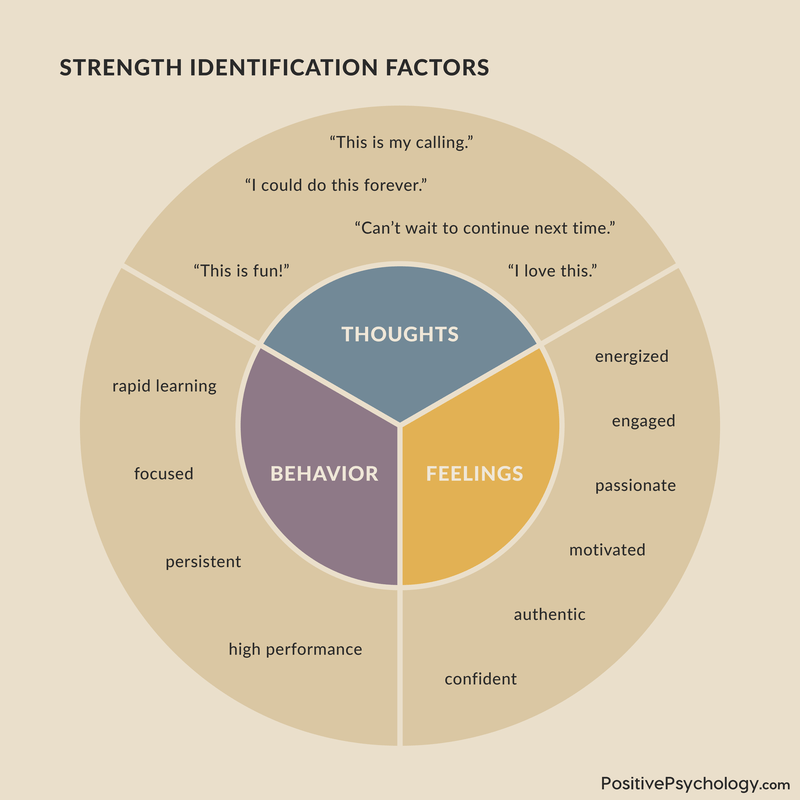Understanding Leadership Strengths in the Workplace
 If you’re a fan of positive psychology, you’ve likely heard a lot about strengths: how to identify your strengths, how to use your strengths, how to maximize and improve upon your strengths, etc.
If you’re a fan of positive psychology, you’ve likely heard a lot about strengths: how to identify your strengths, how to use your strengths, how to maximize and improve upon your strengths, etc.
Not surprisingly, people are generally happier and more successful when they play to their strengths.
This naturally extends to the workplace, where employees who make a purposeful effort to apply their strengths to their work are, on average, more effective, more efficient, and more satisfied with their job.
Smart leaders know this and they plan accordingly, mapping out the ways in which they can use, improve, and maximize their strengths—while also compensating for their weaknesses.
Before you continue, we thought you might like to download our three Positive Leadership Exercises for free. These detailed, science-based exercises will help you or others adopt positive leadership practices and help organizations thrive.
This Article Contains:
- What Strengths are Ideal to Bring to a Position?
- What Are Leadership Strengths?
- A Look at Strengths-Based Leadership
- 5 Examples of a Good Leader using Their Strengths
- Research and Studies
- Understanding Strengths in the Workplace
- Introducing the Strengthscope
- How Can a Leader Best Foster an Employee’s Strengths?
- Strengths When Working in a Team
- Strength Training in the Workplace
- A Take-Home Message
- References
What Strengths are Ideal to Bring to a Position?
We know that applying your strengths in the workplace gives you a competitive advantage and helps you feel more satisfied with your job, but which strengths are the best ones to bring to work?
What Are Employee Strengths?
As you might imagine, the best strengths to bring to work are an employee’s top strengths. Your strengths—that which you do well, that you excel at, or that you are known for—will help you become a more productive, competent, and happy employee, whatever those strengths may be.
Depending on which tool you use to identify your strengths, you might see a wide range of strengths listed, strengths like:
- Analytical
- Ideation
- Strategic
- Curiosity
- Judgment
- Perseverance
- Detail-oriented
- Organizational
- Motivating
- Many, many more
Any of these strengths that you excel in can be your employee strengths if you apply them to your job.
However, there are some strengths that are particularly important to bring to work if you are a manager, supervisor, executive, or in any other leadership position: leadership strengths.
What Are Leadership Strengths?
Simply put, leadership strengths are traits and qualities that serve leaders well, helping them to more effectively lead, manage, and motivate their followers.
They are a subset of the larger realm of strengths. Not all strengths are necessarily leadership strengths, although anyone can learn to apply their own strengths to a leadership role. Leadership strengths are those strengths that are not only helpful to have but nearly vital to have if you want to be an effective leader.
34 Typical Strengths of a Good Manager and Leader
Luckily, those strengths can be acquired and improved by anyone who wishes to become a better leader. They may never be your top strengths, but you can certainly add them to your skill set.
So which strengths are leadership strengths?
It depends on who you ask, but generally, there is agreement on a number of important traits and skills. See the overlap in the three lists of leadership strengths below to get the gist of which strengths most benefit a leader.
According to the IMD business school, there are 8 key leadership strengths:
- Self-awareness: knowing yourself, your strengths, your weaknesses, your emotional state, etc.
- Situational awareness: knowing what is happening around you.
- Communication skills: the ability to effectively communicate with others.
- Negotiation skills: the ability to negotiate and compromise to get the best outcome.
- Conflict resolution skills: the ability to resolve conflict in a way that is fair and agreeable to all (or most).
- Collaboration skills: the ability to work with others, particularly those who are different from you.
- Ability to work with different personal styles and approaches: as described.
- Courage: the ability to make difficult decisions—even when faced with fear, stress, and uncertainty.
The American Management Association has a slightly different list of 10 top leadership traits:
- Results-oriented: focusing on getting results (i.e., good outcomes) rather than the process or getting bogged down in the details.
- Customer-focused: knowing your customers (whether they’re internal or external) and focusing on giving them what they need.
- Vision: having an idea of where you (and your team, division, or organization) want to go.
- Strategically focused: the ability to be strategic in your thinking and planning; seeing the big picture.
- Delegating: the ability to get work done through others and the wisdom to know who to delegate which tasks to.
- Conflict resolution skills: the ability to resolve conflict in a way that is fair and agreeable to all (or most).
- The ability or tendency to ask effective questions: as described.
- Ability to make high-quality decisions based on solid reasoning.
- Trustworthiness: a trait that promotes trust from your followers and peers.
- Communication skills: the ability to effectively communicate with others.
Finally, the Forbes Coaches Council states that these 16 traits and skills are essential for good leadership:
- Fearless agility: the ability to adapt and think on your feet in a fast-paced environment.
- Ability to earn the respect of others: as described.
- Empathy: the ability to understand and appreciate your own emotions and thoughts and the emotions and thoughts of others.
- Selflessness: trait characterized by the tendency to be generous with others and quick to give credit where it’s due.
- Flexibility: the ability to adapt to changing circumstances and work contexts.
- Clear vision: the ability to clarify and commit to a vision for the future.
- Listening skills: the skills necessary to listen effectively—not just “in one ear, out the other” type of listening.
- Humility: the tendency to be modest about your own value and encourage others to shine.
- Communication and “soft” skills: skills like communication, public speaking, and other interpersonal skills.
- Steadiness—while remaining adaptable: the ability to adapt, but also keep a steady core vision and mission.
- Quick learning: the ability to learn quickly, over and above simple recall.
- Cultural intelligence: the ability to effectively work with people from other countries and cultures.
- Individualization: the ability to see and treat others as individuals with unique strengths, weaknesses, needs, etc.
- Authenticity: the trait of being honest, sincere, and wholeheartedly “you.”
- Change leadership: the ability to lead others through times of turbulence and uncertainty, harnessing the creativity and energy of change.
- Versatility: the ability to effectively engage in a wide range of functions and adapt to changing demands.
As you can see, there are a few areas that multiple sources touched on, including:
- Communication
- Flexibility
- Cultural competence
- Vision
- Empathy/Emotional intelligence
- Personal skills (beyond simple communication, like authenticity and trustworthiness)
The leader who builds and uses her strengths in these areas is one that is more likely to be effective.
A Look at Strengths-Based Leadership
Further, the leader who makes it a habit to apply and improve her strengths in her capacity as a leader is one who is engaging in strengths-based leadership.
Strengths-based leadership was defined and popularized by author Tom Rath and leadership expert Barry Conchie. It consists of three important factors:
- Knowing your strengths
- Getting the right talent on your team
- Meeting the basic needs of your followers (Rath & Conchie, 2009)
It’s a simple “recipe for success,” but it’s not necessarily an easy one to follow. It takes work to identify your strengths, even more work to apply them, and even more work to make sure you are applying them in a way that encourages, motivates, and inspires your followers.
5 Examples of a Good Leader Using Their Strengths
So what does strengths-based leadership look like? How do you know when you see it? Check out these 5 examples of effective strengths-based leadership:
- A manager helps his followers identify their own strengths and allows them to apply their strengths in a way that works for them, refraining from blanket policies or over-standardization.
- An executive articulates a clear vision and communicates it effectively to her followers, rather than taking a laissez-faire approach to leading the organization.
- A leader keeps an eye out for potential conflict and has several methods of resolving conflict among her staff instead of ignoring conflict and hoping it will go away or leaving it up to the employees to resolve.
- A team leader hires for good team fit and the strengths that will help the employee succeed in their role instead of hiring based solely on “hard skills,” leading to a more effective team.
- A supervisor who checks in on his employees frequently, working with them one-on-one to help them grow, enhance their abilities, and meet their stretch goals.
Strengths-based leadership – GreggU
Research and Studies
We know what people in the business believe is important for effective leadership, but do we know whether the research backs them up?
Although the literature doesn’t hold all the answers, we have learned quite a bit about positive leadership and leading through strengths over the last few decades, and it’s a bit of a mixed bag. Some old wisdom holds true, while other staples of the business world have fallen short.
5 Interesting Facts
Check out this list of a few things we have learned to get a brief overview of the research on leadership and strengths:
- When it comes to leadership and using your strengths, there is such a thing as overdoing it; some managers have a tendency to overuse their strengths and neglect other behaviors that would benefit them, their team, and their organization (Kaiser & Overfield, 2011).
- Leaders who use their strengths are more effective than those who do not, but leaders who can be flexible and versatile outperform leaders who focus only on their strengths—by a factor of up to 42% (Kaiser, Lindberg, & Craig, 2007).
- The presence and use of leadership strengths were found to be positively related to positive affect and general self-efficacy, as well as global life satisfaction (Weber, Ruch, Littman-Ovadia, Lavy, & Gai, 2013).
- But wait—it turns out that leadership strengths are not necessarily always a positive. In fact, there is evidence that they are related to lower happiness and greater symptoms of depression in adolescents (Gillham et al., 2011).
- Leadership strengths may vary by gender; female leaders tend to be stronger in resilience (Reed & Blaine, 2015).
A strengths-based approach is at the core of positive psychology. If we don’t know what our strengths are, how are we meant to flourish and become the best version of ourselves?
We, as humans, often lack self-awareness of our strengths and don’t realize their power or importance (Linley, 2008). However, when our strengths are combined with effort and awareness, they can be grown into exceptional skills (Biswas-Diener et al., 2011).
There’s plenty of strength identification quizzes and assessments out there that will highlight your supposed strengths for you, but there are also several techniques you can use to spot your own strengths.
By being attentive to thoughts, feelings, and behavior, you can easily identify strengths. For example, imagine your client sharing how happy and energized they felt after learning piano for several hours the day before. From this scenario, you can extract creativity and love of learning as two of their potential strengths, which can be used in several other life domains.
Because the client had positive feelings associated with this activity, they most likely also had thoughts (“I can’t wait to play again) and showed behaviors (e.g., focus, eagerness) indicative of them using their strengths.
If you want more helpful guidance to identify your or your client’s strengths, our PositivePsychology.com Toolkit includes a list of 30 different strength-spotting questions.

Understanding Strengths in the Workplace
It can get confusing with all the different types of strengths that are referenced in the organizational literature. There are personal strengths, leadership strengths, team strengths, organizational strengths, and so on.
It’s important to know that organizational strengths differ from individual strengths. Read on to learn how.
Organizational Strengths
Organizational strengths are strengths that characterize an entire organization. Not every employee will actively apply their organization’s strengths, but it’s likely that the majority of employees have strengths that are similar or related to the organization’s strengths.
As the term implies, organizational strengths are things that organizations do well—just like an individual strength might be attention to detail, an organizational strength might be a robust ability to incorporate feedback from customers and/or employees.
According to the Institute for Manufacturing at the University of Cambridge, an organizational strength can be defined as:
“… a resource or capacity the organization can use effectively to achieve its objectives.”
It’s vital for organizations to not only understand and apply their employees’ strengths but also to understand and apply its own higher-level organizational strengths. One popular way to do this is through what’s called SWOT Analysis.
SWOT stands for Strengths, Weaknesses, Opportunities, and Threats. The analysis is undertaken by spending some serious time and effort identifying each of these factors, then taking it a step further: learning how they interact with one another to create the right circumstances for confronting, avoiding, searching out, or exploiting the strengths and weaknesses of the organization.
Any organization that plans to stay relevant and competitive should pay close attention to its strengths, not only identifying them but finding opportunities to apply them to their advantage.
Introducing the Strengthscope
Are you interested in learning about your own strengths, your team’s strengths, or your organization’s strengths? There are many tools out there for this purpose, but if you want to try a new, promising, and versatile tool, consider the Strengthscope.
The Strengthscope helps you identify your strengths, but it also does more than that—it helps you identify your weaknesses, performance risks, and overdone strengths, if any.
Designed by occupational psychology experts Dr. Paul Brewerton and James Brook, the Strengthscope operates with its own definition of strengths as “underlying qualities that energize you and that you are great at or have the potential to become great at.”
Their model is based on 24 strengths broken into four clusters:
- Emotional strengths: this strength cluster concerns how you make sense of, express, and manage emotions.
- Relational strengths: this strength cluster concerns establishing and maintaining productive relations with others.
- Thinking strengths: this strength cluster concerns how you go about gathering and using information to make decisions.
- Execution strengths: this strength cluster concerns delivering results—what and how they are delivered.
The Strengthscope results in a “Significant 7” strengths, or your top 7 strengths, as well as where the rest of your listed strengths.
How Can a Leader Best Foster an Employee’s Strengths?
So we know it’s a good idea to incorporate strengths into all levels of the organization, but do we really know how to do that?
Strengths in Performance Reviews: What to List or Mention
Thanks to some thoughtful work by researchers Herman Aguinis, Ryan K. Gottfredson, and Harry Joo, we have a great set of recommendations for using strengths to maximize performance reviews and encourage strengths use and development in your employees.
These recommendations include:
- Adopt the strengths-based approach as the primary means of providing feedback.
- Identify the employee’s strengths, provide positive feedback on how they’re using those strengths, and ask them to maintain or improve those behaviors by making more intensive use of those strengths.
- Closely link any negative feedback to employees’ knowledge and skills rather than talents.
- Focus your negative feedback on the more changeable knowledge and skills than the more immutable talents.
- Adopt a strengths-based approach to managing employees’ talent weaknesses.
- Acknowledge that employees’ improvements are unlikely to be large or substantial, create a support system that props up their talent weaknesses, help them see how to use their strengths to compensate for their weaknesses, match them with employees with complementary strengths, and re-design jobs to match the employee.
- Make sure the person providing feedback is familiar with the employee and the employee’s job requirements.
- Ensure that you are familiar with your employees’ knowledge, skills, and talents, as well as their job requirements and work context.
- Choose an appropriate setting when giving feedback.
- Deliver feedback in a private setting.
- Deliver the feedback in a considerate manner.
- Give at least three pieces of positive feedback for every piece of negative feedback, start feedback sessions by asking the employee what’s working, and allow them to participate in the process.
- Provide feedback that is specific and accurate.
- Avoid generic statements like “Good job!” and evaluate and give feedback based on concrete evidence.
- Tie feedback to important consequences at various levels throughout the organization.
- Explain that an employee’s actions and the results have an important impact on the team, unit, and even the organization as well as the employee.
- Follow up.
- Provide specific directions by including a development plan and checking up on progress made (Aguinis, Gottfredson, & Joo, 2012).
Follow these 9 recommendations and you’ll find it easy to incorporate strengths into the process when performance review time comes around again.
Strengths When Working in a Team
Leaders can encourage the development, application, and improvement of their employees’ skills outside of their office as well, and team settings are one of the best places to do it. Not only will employees personally benefit from this practice, but the team will also be more effective.
Character strengths have been found to be significantly related to the successful performance of team roles and, partially through this successful performance, job satisfaction (Ruch, Gander, Platt, & Hofmann, 2018).
Here’s how leaders can harness the strengths of their team:
- Keep the channels of communication wide open.
- Work on relating to each member of the team, understanding their unique strengths, weaknesses, and personalities.
- Be authentic and genuine in your leadership position—just be yourself!
- Create and uphold a vision the team can rally behind.
- Understand the commitment process and understand that commitment may look different for each employee.
- Embody, practice, and encourage trust in the team by listing the unknowns, researching the unknowns, and assessing worst-case scenarios and their survivability.
- Make sure to include all perspectives and make space for each voice at the table (Process Simplification, 2006).
If you follow these 7 recommendations when putting together and managing your team, you will create an effective context for your employees’ strengths to flourish and thrive.
Strength Training in the Workplace
Finally, another great way leaders can foster a workplace that is conducive to strengths application, development, and enhancement is to provide strengths training in the workplace itself.
Fortunately for us, there are tons of opportunities out there for strengths training. Here are just a few of the most popular and well-established training programs and providers:
- Gallup’s Clifton Strengthsfinder for Organizations
- University of Colorado Boulder’s Organization & Employee Development Trainings
- The VIA Institute on Character’s blog walks you through strengths-focused training in your organization
A Take-Home Message
Hopefully you’re leaving this piece with a better understanding of what constitutes a great leader, why focusing on strengths is important in the workplace, and how leaders can best apply a strengths-focused approach with their team, division, or organization.
What are your thoughts on leadership and strengths? Do you think every leader has a different set of strengths or is there one all-encompassing set of strengths that facilitate great leadership? Do you apply your own strengths in a leadership position? If so, how does that work? Let us know in the comments!
Thanks for reading, and happy leading!
We hope you enjoyed reading this article. Don’t forget to download our three Positive Leadership Exercises for free.
- Aguinis, H., Gottfredson, R. K., & Joo, H. (2012). Delivering effective performance feedback: The strengths-based approach. Business Horizons, 55, 105-111.
- Biswas-Diener, R., Kashdan, T. B., & Minhas, G. (2011). A dynamic approach to psychological strength development and intervention. The Journal of Positive Psychology, 6(2), 106-118.
- https://www.amanet.org/articles/top-ten-traits-of-great-leaders/
- Forbes Coaches Council. (2017). 16 essential leadership skills for the workplace of tomorrow. Forbes. Retrieved from https://www.forbes.com/sites/ forbescoachescouncil/2017/12/27/16-essential-leadership-skills-for-the-workplace-of-tomorrow/#3089c11054ce
- Gillham, J., Adams-Deutsch, A., Werner, J., Reivich, K., Coulter-Heindl, V., Linkins, M., Winder, B., …, & Seligman, M. E. P. (2011). The Journal of Positive Psychology, 6, 31-44.
- https://www.imd.org/tbl/leadership-reflections/leadership-strengths/
- Kaiser, R. B., Lindberg, J. T., & Craig, S. B. (2007). Assessing the flexibility of the managers: A comparison of methods. International Journal of Selection and Assessment, 15, 40-55.
- Kaiser, R. B., & Overfield, D. V. (2011). Strengths, strengths overused, and lopsided leadership. Consulting Psychology Journal: Practice and Research, 63, 89-109.
- Linley, P. A. (2008). Average to A+: Realising strengths in yourself and others. CAPP Press.
- Process Simplification. (2006). Harnessing the strengths of a team: Guidelines for process simplification leaders. University of Virginia. Retrieved from http://www.virginia.edu/processsimplification/doc/TeamLeadership.doc
- Reed, D. E., & Blaine, B. (2015). Resilient women educational leaders in turbulent times: Applying the Leader Resilience Profile to assess women’s leadership strengths. Planning & Changing, 46, 459-468.
- Ruch, W., Gander, F., Platt, T., & Hofmann, J. (2018). Team roles: Their relationships to character strengths and job satisfaction. The Journal of Positive Psychology, 13, 190-199.
- Weber, M., Ruch, W., Littman-Ovadia, H., Lavy, S., & Gai, O. (2013). Relationships among higher-order strengths factors, subjective well-being, and general self-efficacy—The case of Israeli adolescents. Personality and Individual Differences, 55, 322-327.
Let us know your thoughts
Read other articles by their category
- Body & Brain (49)
- Coaching & Application (57)
- Compassion (26)
- Counseling (51)
- Emotional Intelligence (24)
- Gratitude (18)
- Grief & Bereavement (21)
- Happiness & SWB (40)
- Meaning & Values (26)
- Meditation (20)
- Mindfulness (45)
- Motivation & Goals (45)
- Optimism & Mindset (34)
- Positive CBT (28)
- Positive Communication (20)
- Positive Education (47)
- Positive Emotions (32)
- Positive Leadership (18)
- Positive Parenting (4)
- Positive Psychology (33)
- Positive Workplace (37)
- Productivity (16)
- Relationships (46)
- Resilience & Coping (36)
- Self Awareness (21)
- Self Esteem (37)
- Strengths & Virtues (31)
- Stress & Burnout Prevention (34)
- Theory & Books (46)
- Therapy Exercises (37)
- Types of Therapy (64)





What our readers think
My strengths,
6 subject matters
Self reliance
Serious subject matter only
Sincerely
Scott Rosenstein
Very well articulated and very useful article for the frontline managers.
Great insight into leadership strengths. Very thought provoking! It is getting me thinking about how I develop my own strengths and to look at areas I am less developed in. Many thanks for getting me thinking.
Very well presented.thankyou.